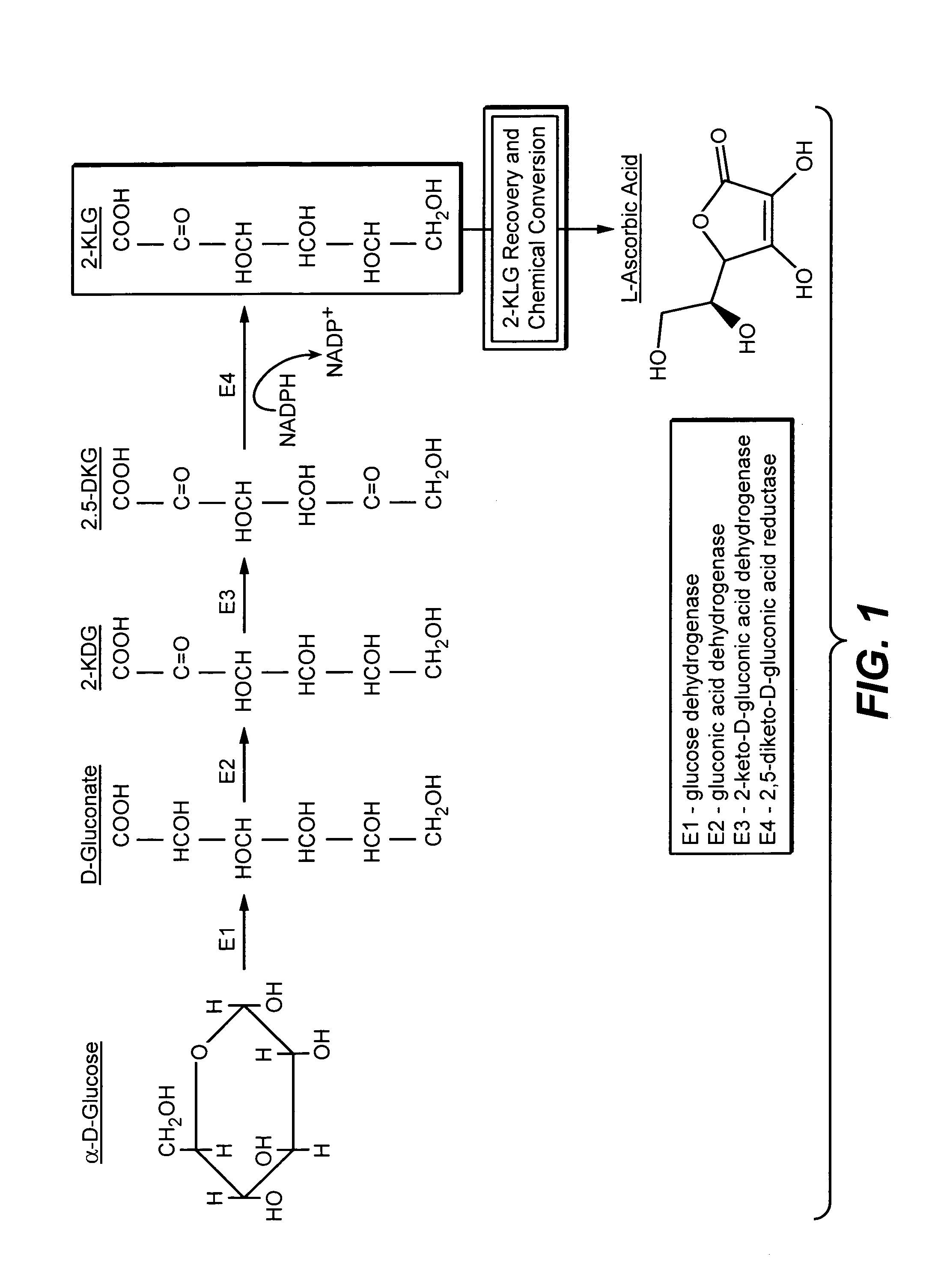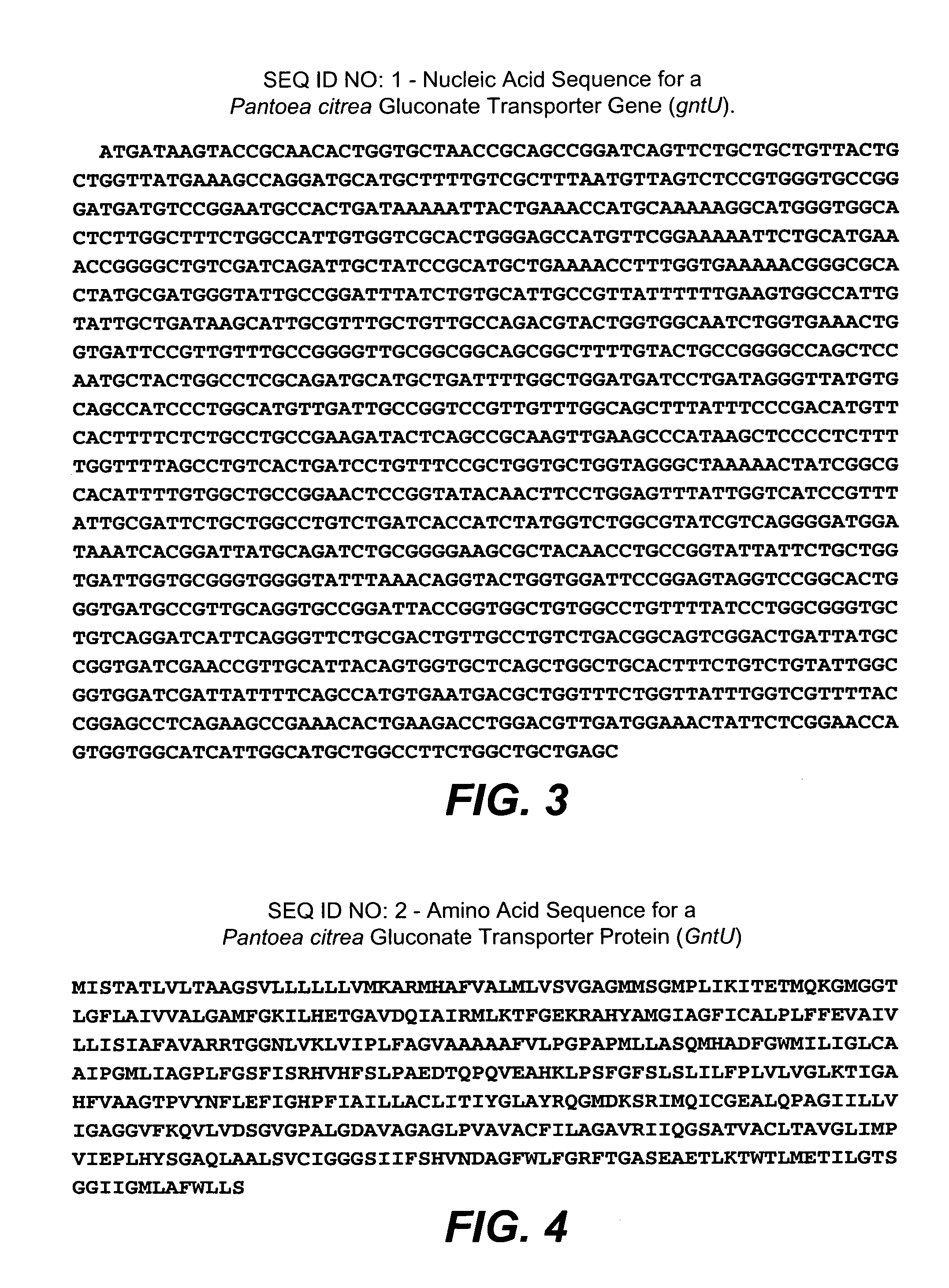Metabolically engineered bacterial strains having non-functional endogenous gluconate transporters
a technology of endogenous gluconate and metabolic engine, which is applied in the direction of transferases, peptide/protein ingredients, instruments, etc., can solve the problems of reducing the efficiency and overall production of asa intermediates, increasing or decreasing the availability of substrates for a particular metabolic pathway, etc., and achieves the effect of increasing the productivity of the host cell and increasing the yield of the desired produ
- Summary
- Abstract
- Description
- Claims
- Application Information
AI Technical Summary
Benefits of technology
Problems solved by technology
Method used
Image
Examples
example 1
Inactivation of the gntU ORF Encoding a Gluconate Transporter in P. citrea
[0146]A 1934-bp DNA fragment containing the gntK and gntU structural genes from Pantoea citrea was amplified by PCR with GntKUF1 (SEQ ID NO:5) plus GntKUR1 (SEQ ID NO:6) primer pairs using standard techniques (Sambrook et al., MOLECULAR CLONING: A LABORATORY MANUAL, Cold Spring Harbor Laboratory Press (1989) 2nd Ed.). In addition to the structural genes, the PCR fragment carries 27 bp upstream of the gntK gene and 23 bp downstream of the gntU (FIG. 7). This PCR product was cloned into the HindIII site of pCL1920 vector resulting in plasmid pCL-GntKU2 (6489-bp) (Lerner et al., (1990) Nucleic Acids Res. 18:4631). This was constructed into E. coli TOP10 strain (Invitrogen, Carlsbad, Calif.) and checked by EcoRI and PstI restriction enzymes for correct insert and orientation.
Construction of the Plasmid Used to Inactivate gntU:
[0147]In general, the strategy used to inactivate genes by ho...
example 2
Inactivation of the idnT ORF Encoding a Gluconate Transporter in Pantoea citrea
Construction of the idnDT Deletion Plasmid:
[0154]Primers PcldnT-1 (SEQ ID NO:12) and PcldnT-2 (SEQ ID NO:13) were designed approximately 1 kb upstream and 1 kb downstream of the idnT gene (SEQ ID NO:3). The amplification of PCR product of 1473-bp was obtained and cloned into pUniBluntV5-His-Topo (Echo Cloning System from Invitrogen). The resulting plasmid was transformed into E. coli PIR1 strain (Invitrogen, Carlsbad, Calif.) and appropriate restriction enzymes were used to check for the correct orientation of the gene.
[0155]IdnT gene was interrupted using BgII enzyme followed by insertion of a cat-loxP (1080-bp) cassette (Palmeros et al., (2000) Gene 247:255-264) resulting in plasmid pEkIdnTCat2 (4813-bp). As described in example 1, the orientation of the cat-loxP cassette was checked with appropriate restriction enzymes.
[0156]The following 2 primers PcIdnD5 (SEQ ID NO:14)+PcIdnD6 (SEQ ID NO:15) were us...
example 3
Shake Flask Experiments
[0163]Three strains of Pantoea citrea were used in this example:[0164](1) Strain 139-2A / pD92 was used as a control.[0165](2) Strain MDP41 / pD92A disclosed in WO 02 / 081440 which includes an interruption in glkA.[0166](3) Strain MDP41UDT / pD92-A (as described above in examples 1 and 2) which includes an interruption in g / kA and a deletion in gntU and idnT.
[0167]These strains were grown in the following medium (KH2PO4(12.0 g / L); K2HPO4 (4.0 g / L); MgSO4.7H2O (2.0 g / L); Difco Soytone (2.0 g / L); Sodium citrate (0.1 g / L); Fructose (5.0 g / L); (NH4)2SO4 (1.0 g / L); Nicotinic acid (0.02 g / L); FeCl3.6H2O (5 mL / L of a 0.4 g / L stock solution) and Trace salts (5 mL / L—of the following solution: 0.58 g / L ZnSO4.7H2O, 0.34 g / L MnSO4.H2O, 0.48 g / L Na2MoO4.2H2O) with fructose as the sole carbon source or with a mixed carbon source (fructose, gluconate and DKG) in the range from 0.1% to 1.0%. Cells were grown at a temperature between 20-37° C., (preferably below 30° C.) and at a pH 7...
PUM
| Property | Measurement | Unit |
|---|---|---|
| temperature | aaaaa | aaaaa |
| temperature | aaaaa | aaaaa |
| pH | aaaaa | aaaaa |
Abstract
Description
Claims
Application Information
 Login to View More
Login to View More - R&D
- Intellectual Property
- Life Sciences
- Materials
- Tech Scout
- Unparalleled Data Quality
- Higher Quality Content
- 60% Fewer Hallucinations
Browse by: Latest US Patents, China's latest patents, Technical Efficacy Thesaurus, Application Domain, Technology Topic, Popular Technical Reports.
© 2025 PatSnap. All rights reserved.Legal|Privacy policy|Modern Slavery Act Transparency Statement|Sitemap|About US| Contact US: help@patsnap.com



